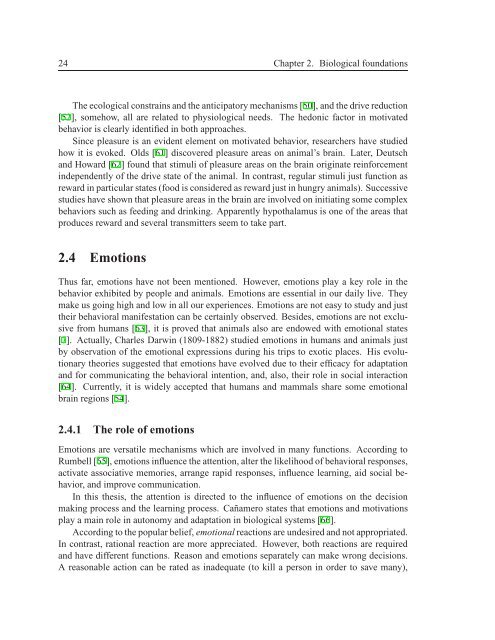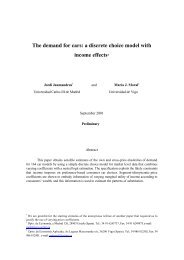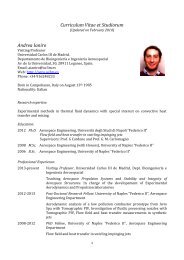TESIS DOCTORAL - Robotics Lab - Universidad Carlos III de Madrid
TESIS DOCTORAL - Robotics Lab - Universidad Carlos III de Madrid
TESIS DOCTORAL - Robotics Lab - Universidad Carlos III de Madrid
Create successful ePaper yourself
Turn your PDF publications into a flip-book with our unique Google optimized e-Paper software.
24 Chapter 2. Biological foundationsThe ecological constrains and the anticipatory mechanisms [50], and the drive reduction[52], somehow, all are related to physiological needs. The hedonic factor in motivatedbehavior is clearly i<strong>de</strong>ntified in both approaches.Since pleasure is an evi<strong>de</strong>nt element on motivated behavior, researchers have studiedhow it is evoked. Olds [61] discovered pleasure areas on animal’s brain. Later, Deutschand Howard [62] found that stimuli of pleasure areas on the brain originate reinforcementin<strong>de</strong>pen<strong>de</strong>ntly of the drive state of the animal. In contrast, regular stimuli just function asreward in particular states (food is consi<strong>de</strong>red as reward just in hungry animals). Successivestudies have shown that pleasure areas in the brain are involved on initiating some complexbehaviors such as feeding and drinking. Apparently hypothalamus is one of the areas thatproduces reward and several transmitters seem to take part.2.4 EmotionsThus far, emotions have not been mentioned. However, emotions play a key role in thebehavior exhibited by people and animals. Emotions are essential in our daily live. Theymake us going high and low in all our experiences. Emotions are not easy to study and justtheir behavioral manifestation can be certainly observed. Besi<strong>de</strong>s, emotions are not exclusivefrom humans [63], it is proved that animals also are endowed with emotional states[7]. Actually, Charles Darwin (1809-1882) studied emotions in humans and animals justby observation of the emotional expressions during his trips to exotic places. His evolutionarytheories suggested that emotions have evolved due to their efficacy for adaptationand for communicating the behavioral intention, and, also, their role in social interaction[64]. Currently, it is wi<strong>de</strong>ly accepted that humans and mammals share some emotionalbrain regions [54].2.4.1 The role of emotionsEmotions are versatile mechanisms which are involved in many functions. According toRumbell [65], emotions influence the attention, alter the likelihood of behavioral responses,activate associative memories, arrange rapid responses, influence learning, aid social behavior,and improve communication.In this thesis, the attention is directed to the influence of emotions on the <strong>de</strong>cisionmaking process and the learning process. Cañamero states that emotions and motivationsplay a main role in autonomy and adaptation in biological systems [66].According to the popular belief, emotional reactions are un<strong>de</strong>sired and not appropriated.In contrast, rational reaction are more appreciated. However, both reactions are requiredand have different functions. Reason and emotions separately can make wrong <strong>de</strong>cisions.A reasonable action can be rated as ina<strong>de</strong>quate (to kill a person in or<strong>de</strong>r to save many),






